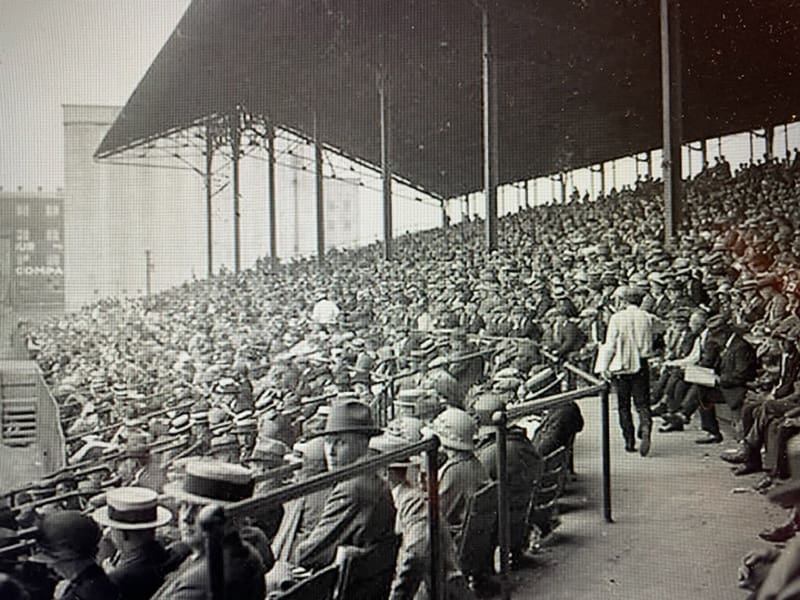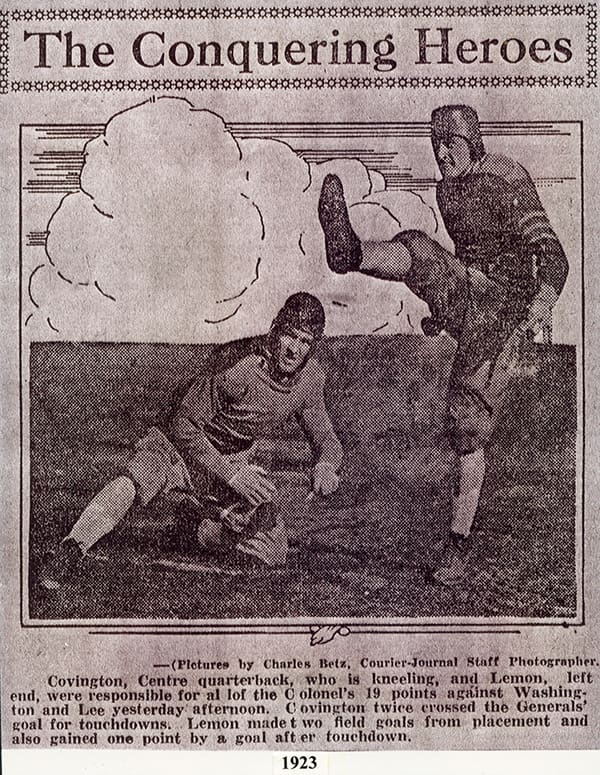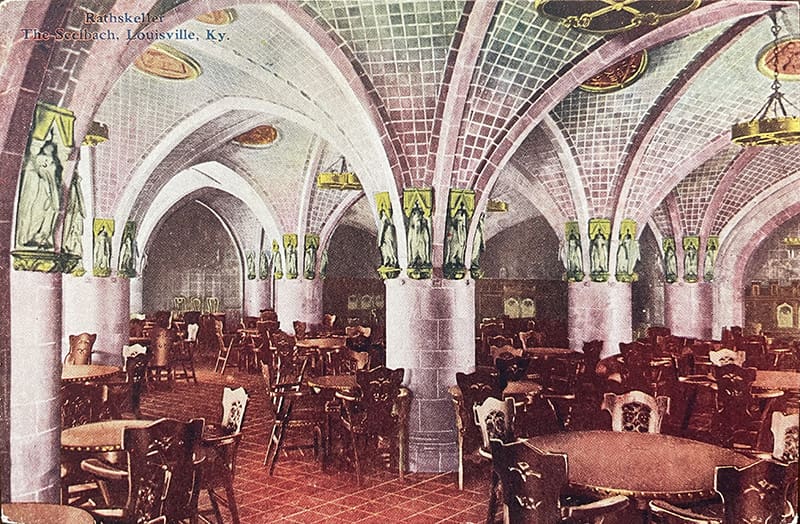November 24, 1923 To Louisville and The Generals of W&L
Washington and Lee and Centre were to play for the third time in Louisville. The 1921 game was the first ever in the two school's history, and Centre won 25-0. The Colonels repeated in 1922, winning 27-6. W&L had become somewhat like Kentucky in that it felt, "This is the year!"

Centre was looking to go 5 for 5 in Louisville
W&L's record when it headed to Louisville was 5-1-1 or 5-2-1. This needs some discussion. Contemporary accounts indicated that the Generals had forfeited a game with Washington and Jefferson, a Pennsylvania powerhouse during the era. However, W&J doesn't even list the game in its records for 1923. What happened was that W&J had a black halfback. Washington and Lee wouldn't play if the black half participated, and W&J did the correct thing and sent word that all its players played, or it didn't play at all, so the game was called off. It was cancelled according to W&J, not forfeited, but the all-time records on the Washington & Lee website indicate that the game should be carried as a 1-0 forfeit.
Another game on W&L's 1923 schedule also needs some clarification. W&L was shooting for the Southern Conference title. It had a game with non-member West Virginia on November 10, and lost 63-0. It was reported that since the game was meaningless in the race for the Southern Conference title, W&L sent some sacrificial 3rd stringers over to Charleston, West Virginia, and held back its regulars for later games with conference members, South Carolina and North Carolina State.
W&L 19 Western Maryland 7
W&L 6 Kentucky 6
W&L 28 St. John's 0
W&L 12 Virginia Tech 0
W&L 7 Virginia 0
W&L 0 West Virginia 63
W&L 13 South Carolina 7
Kentucky was a common opponent for W&L and Centre. The comparable scores would make Centre a favorite, as the Colonels beat the Wildcats much more convincingly than the 10-0 score would indicate, and W&L and Kentucky tied, 6-6.
Centre had played all of its previous Louisville games from 1919-22 at Eclipse Park, but a fire destroyed the facility and a new baseball park, which could also host a football game, was constructed south of the downtown on Eastern Parkway near the campus of the University of Louisville. Parkway Field was built of steel and concrete and at its completion, was one of the finest minor league parks in the country. It had permanent seating for 13,496, and the addition of some outfield bleachers allowed the promoters of the game to sell over 15,000 tickets which were taken quickly.

Louisville's Parkway Field which could be adapted for football due to its configuration

Crowd at Parkway Field, the new stadium built after the fire destroyed Eclipse Park in 1922. Note the attire, with everyone dressed so differently than what we now see at games.
The two schools, meeting for the third time, pretty much knew the routine in Louisville, just as Centre and Auburn had grown so comfortable in Birmingham. Centre headed to the Seelbach Hotel and W&L to the Watterson.

Watterson Hotel-W&L headquarters
Nearly the entire Centre's student body booked the Southern's $5.04 round-trip fare to Louisville.
The Colonels invited the Kentucky team and coaches, who didn't play again until Thanksgiving, to be their guests, and with all of the Danvillians and Lexingtonians going to Louisville, the Southern scrambled to get enough day coaches added to its regular trains to accommodate the huge number of passengers.
People loved to come to Louisville. It was the only metropolitan city in Kentucky, and including the towns just across the Ohio River in Indiana, there were 350,000 people in the area.
( Lexington was a distant second with a population of approximately 55,000 in all of Fayette County.)
Louisville had the widest streets, the tallest buildings, the best hotels, the most fashionable stores, the best restaurants, and more theatres and opportunities for cultural advancement. Louisville was a big city with Southern charm, and possessed everything a Kentuckian could want- except a decent football team. Centre had done much to fill that void since its first game there in 1919.
Coming into the W&L game, Bob Dundron of the Louisville "Herald" had some observations about Uncle Charlie.
The season has demonstrated one thing. That is, it was really Moran's cleverness which built up Centre, and not, as many thought, the mere fact that he had the great star, Bo McMillin, on his team. Moran has taken material admittedly inferior to McMillin and Roberts, and has constructed a team that is able to win, and which plays a more varied game than when he had the luminaries mentioned here. We have known Uncle Charlie as a baseball player, an umpire, and a football coach. He is, with it all, a good fellow, but he is a hard driver on the field. That is what it takes to win. One must be relentless to score. Moran is of a natural, kindly disposition, and his men are all for him, but they realize that he will exact all that they can give him in a game.

Uncle Charlie is in the center. Top row of the players left to right- Ed Kubale, Case Thomasson, Hope Hudgins and local Louisvillian, Jimmy Green. Bottom left, George Chinn. Bottom right, Herb Covington
You know, like I've said, we'd had several members of the team in our fraternity, the Phi Delts. Red Roberts, Hump, Terry Snowday, Bill Shadoan, Hope Hudgins, Tom Bartlett, Les Combs- they were all on the team.
They'd talk about Uncle Charlie a lot. He could be hard on them, sure, trying to make them the best they could be. But I never heard one player say anything negative about him.
You know, there are some people who you just want to please. You look up to them and want to do your best and get their approval. That's the way the team felt about Uncle Charlie. They didn't want to disappoint him. They wanted to hear his approval. They lived for that approval. I always thought that was a huge factor in what made him and the team so successful. Whatever he said, they'd die trying to do it.
You can't make people respect you. You have to earn that respect. Uncle Charlie was the type who everybody on the campus and in the town loved and respected. He was that kind of guy.
Centre played almost as perfectly in Louisville against W&L as it had in Birmingham against Auburn. Again, the defensive effort was outstanding. Captain Ed Kubale was constantly urging on his teammates, cheering them to greater and greater effort.
The Centre leader was actually knocked out cold when he made a devastating hit on a W&L runner, but time was called and he was revived and continued playing.
( Can you imagine that happening today? At a minimum, a player would have been put on a stretcher, restrained so that he couldn't move about, taken immediately to a hospital, undergone an emergency CAT scan, and probably admitted for observation overnight even if the scan had been normal. Kubale was administered "smelling salts" and when he became responsive, he continued to play! But that was then, and now is now, and obviously things have changed, this time for the better. )
Jop was continuing to jazz up his reporting.
The fans who witnessed the grid battle were sent into pulsating throbs of ecstatic glee by the thrilling accomplishments of Covington, the Colonel sky rocket, who went cork-screwing, spinning and weaving his way through the Virginian' s defense.
The little busy body, who was prying into everything all afternoon, carried the ball 4 times in the first 7 formations clicked off by Centre and gained a total of 57 yards. Three of the plays were end runs off kick formations, his interference forming magnificently on his dashes. After he took it in for the first score, Lemon kicked goal after touchdown.
One of those leading the interference was Frank Rubarth. After returning from the Auburn game, Rubarth had his nose x-rayed as it seemed to sit somewhat askew on his face. It was broken, of course, and that caused Uncle Charlie to swing into action with one of his protective contraptions. Rubarth didn't miss a minute of the W&L game.
The Generals played Centre to a standstill in the second quarter. Their big fullback, Captain Edmund Cameron, played heroically just as he had in 1922. Time after time he'd lower his head and rip into Centre's line, but his efforts were mostly in vain as he didn't have a line in front of him which could overcome the Colonels' defense.
The half ended, 7-0.
Watching the game from the Centre bench was big Bill Shadoan, who had come down from Valparaiso. The former Centre lineman was in Louisville not only to cheer on his old team, but to discuss the possibility of his Valpo team meeting the Colonels in 1924.
Centre dominated the second half. The Colonels were content to run power plays over the guards and tackles, much as they had done against Auburn.
Ben Cregor had heaped praise on his linemen at the half.
"You're controlling the line of scrimmage. As long as you continue driving them back, Uncle Charlie wants the ground game to predominate."
Again, Ed Kubale cheered his "mates" on. "Take it to them, lads!"
George Chinn said, "Captain, you're from Fort Smith, Arkansas. The closest you've been to merry England is Boston in New England for a couple of days."
Twice, Covey led drives which got within field goal range, and twice Hennie Lemon converted, once from the 20, and the second effort, "a kick at a very difficult angle," from the 22. It was 13-0 after three quarters.

Hennie Lemon and Herb Covington, two from Mayfield, Kentucky
Covey had an electrifying run in the 4th quarter when he intercepted a pass at the 50 yard line and through a brilliant display of broken field running, cut back, then reversed, and zigged and zagged down the field for a score, which unfortunately, was nullified when it was determined that he had stepped out of bounds on the 40.
From the 40, Covey then led a march, and he took it in from the 8. Lemon missed, and the score ended at 19-0.


Centre had a total yardage gained of 270 to 129 for W&L
Just as Uncle Charlie had been sensitive to the fact that Jimmy Green was playing his last game in Danville, we was also aware of the Louisville native appearing for the last time in his home town. Again, Jimmy was put in as the clock wound down and received the same standing ovation that he had gotten near the end of the Kentucky game.
In the 3 games in Louisville, Centre found W&L to be a worthy opponent. The Generals played hard, and they displayed wonderful sportsmanship. But Centre was a better team during the era, as evidenced by the fact that the Colonels outscored the boys from Lexington, Virginia, by a total of 71-6.
After the 1923 game, Centre and W&L didn't play again until 1933, when the two colleges met in Danville, with Centre winning, 13-0. Currently, the two teams have met 62 times, with Centre having a 38-22-2 winning record overall.
The Colonels stayed overnight in Louisville the Saturday night after the game. There was another of those memorable parties hosted by the alumni of both of the schools, this time at the wonderful Rathskeller at the Seelbach.

The Rathskeller at the Seelbach Hotel, site of the party for the Generals and Colonels after the game
The rumor was already being circulated that Centre may not return to Louisville in 1924 due to the fact that the college wanted to schedule as many games as possible in the new stadium. It was agreed by all that if the Louisville series ended, everyone from Centre and Danville would always remember the wonderful experiences and hospitality that had been afforded the school during the last 5 years.
The Colonels had compiled a tremendous record in the city, outscoring their opponents, 155-6.
1919 Centre 56 DePauw 0
1920 Centre 28 Virginia Tech 0
1921 Centre 25 W&L 0
1922 Centre 27 W&L 6
1923 Centre 19 W&L 0
Centre had competed brilliantly in the 5 appearances. Equally as important as the Colonels' efforts during the games was their conduct off the field. They had developed lasting friendships and cemented relationships which bonded Centre College and the citizens of the state's principal city, and they were a major influence in creating a special relationship between Centre and Louisville which exists to this day.
